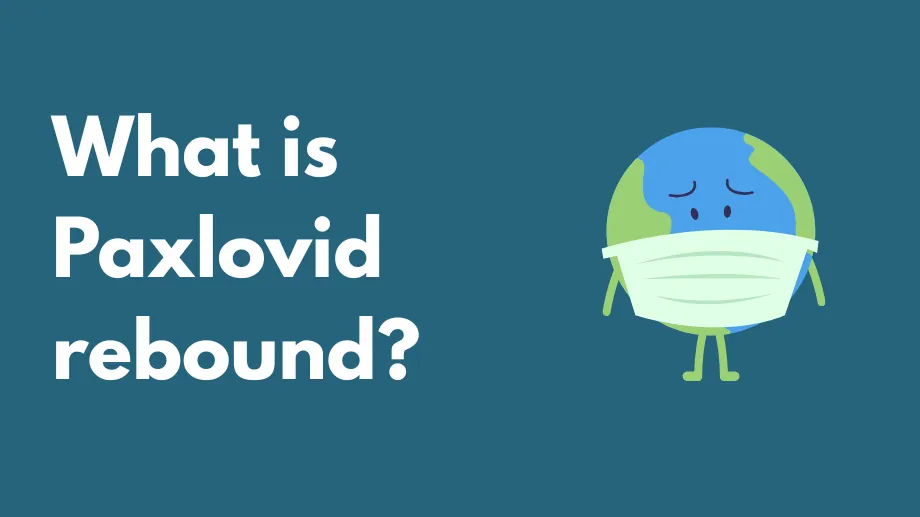What is Paxlovid rebound?

When you test positive for COVID-19 or start experiencing symptoms, your doctor may prescribe you Paxlovid if you are at a higher risk of having a severe illness that may require hospitalization. Paxlovid is an oral antiviral treatment that can have you feeling better and testing negative sooner than you would have without it. Since its use has increased, some people have developed what the media is calling “Paxlovid rebound.”
The Centers for Disease Control and Prevention (CDC) defines Paxlovid rebound as someone who, after receiving a full five-day course of Paxlovid, either has a return of symptoms or a positive test after a previous negative test. It has been reported that this rebound typically occurs between 2 to 8 days after your initial recovery. This includes people who are up to date on their COVID-19 vaccinations.
It is difficult to know if Paxlovid is actually the cause of this rebound. It is also hard to differentiate between rebound symptoms and those that simply linger — or those of long COVID. Research has shown that rebound COVID occurs in both people who have been treated with Paxlovid and those who haven’t. COVID-19 rebound also happens after treatment with Lagevrio (molnupiravir), another oral antiviral treatment for COVID-19. Infectious disease specialists believe a rebound may be part of the natural course of the COVID-19 infection in some people, regardless of treatment with Paxlovid or their vaccination status.
Let’s discuss more about Paxlovid and what you can do if you experience rebound symptoms.
Paxlovid FAQs
What is Paxlovid used to treat?
Paxlovid (nirmatrelvir/ritonavir) is an antiviral combination that was approved under a U.S. Food and Drug Administration (FDA) Emergency Use Authorization (EUA). It is used to treat mild-to-moderate COVID-19 (SARS-CoV-2 or 2019 novel coronavirus) in patients 12 years and older (weighing over 88 lbs) who are at high risk for a severe COVID-19 infection. Those at higher risk include people with lung or heart disease, cancer, obesity, diabetes, and other conditions.
How does Paxlovid work?
Paxlovid is an oral COVID-19 treatment that contains two protease inhibitors: ritonavir and nirmatrelvir. Nirmatrelvir blocks a viral protein needed for coronavirus replication. Ritonavir boosts levels of nirmatrelvir. Together, they help reduce COVID-19 symptoms and your risk of hospitalization. Paxlovid should work against the Omicron variant, the dominant strain in the U.S. today.
What are the side effects of Paxlovid?
The most common side effects of Paxlovid in clinical trials include:
- Change in taste
- Diarrhea
Some other possible side effects may include:
- Headache
- High blood pressure
- Nausea
- Vomiting
- Stomach pain
Rarely, Paxlovid may cause serious side effects such as severe allergic reactions (hives, swelling of the face, lips, tongue, or throat, and shortness of breath).
These are not all the possible adverse effects of Paxlovid. You should always seek medical advice from a healthcare professional for any questions or concerns about your medical condition or treatment. You should also read all the patient information, including your Medication Guide that comes with Paxlovid. You can report side effects to the FDA at 1-800-FDA-1088 or www.fda.gov/medwatch.
Who should not take Paxlovid?
You should not take Paxlovid if you are allergic to ritonavir, nirmatrelvir, or any inactive ingredients in this product. You should also avoid Paxlovid if you take certain medications that may cause serious drug interactions. See the package insert or Medication Guide for a full list.
What does your healthcare provider need to know before you start taking Paxlovid?
Your healthcare provider should be aware of all your medical conditions, as you may need increased monitoring or dose adjustments. This includes:
- Kidney or liver problems
- Human Immunodeficiency Virus 1 (HIV-1)
- Pregnancy or plans to become pregnant
- Breastfeeding or plans to breastfeed
Are there any drug interactions with Paxlovid?
Paxlovid can interact with many medications metabolized by the CYP3A enzyme, such as certain statins, blood thinners, antiarrhythmics, immunosuppressants, migraine medications, and antidepressants. Ask your healthcare provider or consult the Paxlovid package insert for a complete list.
Is Paxlovid rebound contagious?
If you experience Paxlovid rebound, you can be contagious. You may have rebound COVID without symptoms and still spread the virus. Follow all isolation and quarantine guidelines given at the time of your positive test.
How common is COVID-19 rebound in people who took Paxlovid?
Clinical studies have shown rebound in both Paxlovid and placebo groups. In one study, about 2.3% of Paxlovid users experienced rebound versus 1.7% on placebo. Another study reported rebound in 14% of Paxlovid users and 9% of those untreated.
Who is at risk for COVID-19 rebound after taking Paxlovid?
A 2022 preprint study identified risk factors associated with rebound:
- Medical conditions increasing COVID-19 severity risk
- Organ transplant recipients
- Smokers
- People on immunosuppressant medications
Further research is needed to confirm these findings. Ongoing clinical trials aim to clarify rebound rates in people with weakened immune systems.
How quickly does Paxlovid treatment start to work?
Paxlovid begins working immediately, but you may not notice symptom relief for 1–2 days. It can take several days for full symptom resolution. Some symptoms like fatigue or cough may linger for weeks or months, but Paxlovid effectively reduces hospitalization risk.
How fast does Paxlovid rebound happen?
Paxlovid rebound refers to symptom recurrence or a new positive test 2 to 8 days after initial recovery following a 5-day course of treatment.
How do I get rid of Paxlovid rebound?
There are no specific treatments for rebound symptoms. Over-the-counter cold medications may help alleviate symptoms but will not clear the virus. Seek medical attention if you develop severe symptoms.
Related medications
- Veklury (remdesivir)
- Lagevrio (molnupiravir)
